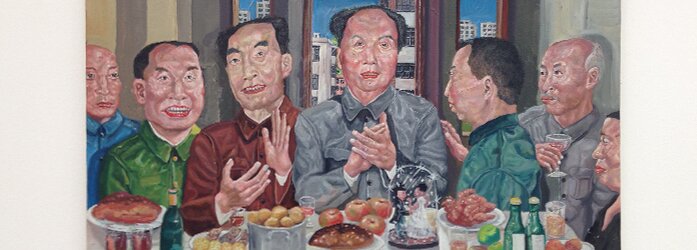
Liu Wei, The Last Supper, 1993 – Post Pop: East Meets West Exhibition at Saatchi Gallery, 26 November 2014 - 23 February 2015 / Photo by Yanti Sastrawan
This November, with the Tsukanov Family Foundation, Saatchi Gallery presents a retrospective exhibition with 250 works from 110 artists in exploring and observing the influence of the Pop Art movement throughout the twentieth century. ‘Post Pop: East Meets West’ is the first exhibition on this particular movement, offering the contrasting influences from these set of Russian, Chinese, Taiwanese, British and American artists in perceiving Pop Art. As the exhibition is publicly opened from 26th November, Ultra Vie has the inside track from Saatchi Gallery’s ‘Post Pop: East Meets West’.
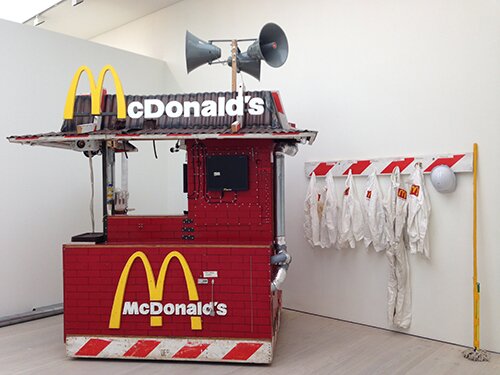
Tom Sachs, Nutsy's MacDonald's, 2001 – Post Pop: East Meets West Exhibition at Saatchi Gallery, 26 November 2014 - 23 February 2015 / Photo by Yanti Sastrawan
The exhibition finds its specific themes in each gallery rooms, showcasing the level of strength has clearly placed itself in our daily lives. In taking over the gallery, these themes include Habitat, Advertising and Consumerism, Celebrity and Mass Media, Art History, Religion and Ideology, as well as Sex and the Body. Additionally, ‘Post Pop: East Meets West’ examines the relationship between Pop-Art in western region and in lesser-known eastern countries. This observation takes concern on “Sots Art” in the Soviet Union and “Political Pop” or “Cynical Realism” in Greater China that starts its influences throughout the twenty-first century.
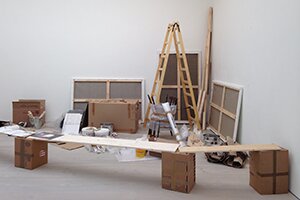
Ilya and Emilia Kabakov, Unfinished Installation – Post Pop: East Meets West Exhibition at Saatchi Gallery, 26 November 2014 - 23 February 2015 / Photo by Yanti Sastrawan
Aesthetically, Pop Art examines lives closely that it forms the artefacts in our surrounding such as our homes, which would define ourselves. The first room explores Pop-Art in our Habitat, as artists represent Pop Art incorporating architectural features into artworks and installations, as well as producing interior furnitures with art elements. One attentive displayed work would be the composed ‘Incident in the Corridor near the Kitchen’ (1989) by Ilya and Emilia Kabakov. The arranged clutter that would normally seem as a mess becomes a poetic structured installation, presenting a visual narrative of the kitchen environment between romance and arguments. In contrast, Ilya and Emilia Kabakov also showcase ‘Unfinished Installation’, a literal unfinished installation work. As the whole concept is within the installation essence and its very own definition, this particular work blurs the boundaries between the artist’s preparation and the viewer’s expectation.
Advertising has also acted its role for Pop artists in producing works from major brand aesthetics to its techniques in creating bold visual statements. Advertising and Consumerism place these ideas in their influence for Pop artists in approaching attentive statements in their conceptual works – similar to the work of advertising. Among the works, Tom Sachs’ ‘Nutsy MacDonald’s’ (2001) is a highlight, as it lets viewers perceive the installation in showcasing the labour work behind the seemingly appealing fast-food chain.
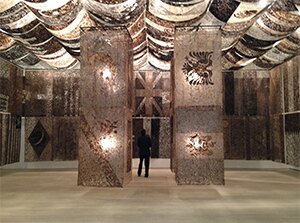
Gu Wenda, United Nations – Man and Space (1999-2000) – Post Pop: East Meets West Exhibition at Saatchi Gallery, 26 November 2014 - 23 February 2015 / Photo by Yanti Sastrawan
As Pop Art’s influences intertwine with everyday lives, the ideas can also be seen within Ideology and Religion. For many, belief is a strong element in maintaining life and keeping faith. Yet, Pop Art plays a controverting part when it is implied in the views of religions and ideologies. The featured works are indication that this particular theme is remained as a powerful reference point, particular for Russian and Chinese artists, in finding themselves from the recent past. One of the depictions that recurs throughout this theme is different artists’ representation of ‘The Last Supper’ painting, such as Liu Wei’s ‘Last Supper’ (1993). Additionally, Gallery 10 becomes one of the major highlights of this exhibition as it hosts Gu Wenda’s ‘United Nations – Man and Space’ (1999-2000) installation, of displayed country flags made from human hair. The vivid, immense installation takes over the room in representing a union, which can be perceived literally as the assembled flags are within a particular shade of colour, forming the space and plays with the level of roaming spectators.
With the youth culture, Sex & The Body room recognises the male artists’ perspective in giving a sharp social and political commentary, which correlates to the next two themes on Art History and Mass Media. The idea of ‘art about art’ is very much the definition carried by Pop artists in acknowledging art history while creating a completely new and original artwork. From reinventing familiar sculptures such as seen in Sui Jianguo’s ‘Clothes Vein Studies: Discobolus’ (1998), to the representation of Marcel Duchamp’s ‘Fountain’ by Robert Gober, Leonid Sokov, Sergey Shutov, Alexander Kosolapov, and Sherrie Levine. Seemingly, Pop Art is no longer just within ‘art about art’, but a reinvention of the notion, leading to a new concept of remaking art about art, to make a somewhat original art.
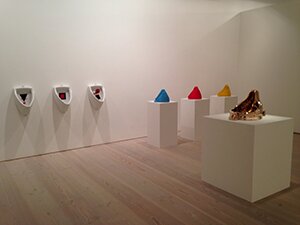
The Representations of Marcel Duchamp's 'Fountain' – Post Pop: East Meets West Exhibition at Saatchi Gallery, 26 November 2014 - 23 February 2015 / Photo by Yanti Sastrawan
The final rooms of the exhibition play homage to Pop Art in Mass Media, which majorly signifies the Pop Art movement since its renowned popularity. Although mediated and manipulated, the imagery of brands, products and celebrity are communicated into a greater audience that could even lead to constructing national aspirations. These views are differently perceived in the variant works, but one that struck most is Vladislav Mamyshev-Monroe photograph portraits from the series ‘Life of Great Monroe’. The series depict the consistency of the consequence of mass media as these portraits can be instantly recognised even when it was being acted by a different person.
While the range of works originate from different cultural backgrounds, the exhibited works do explore the imagery from advertising, to patriotic motifs as a reference to this strong movement. certainly is a comprehensive exhibition in learning the Pop Art movement from certain point of views, and how it is a powerful influence in the global art scene, then and now.
Post Pop: East Meets West
26 November 2014 – 23 February 2015
Saatchi Gallery
Duke of York’s HQ,
King’s Road,
London SW3 4RY
 LIVE FEEDS
LIVE FEEDS


 PARIS PHOTO FAIR 2014 | THE INTERNATIONAL ART FAIR FOR PHOTOGRAPHY
PARIS PHOTO FAIR 2014 | THE INTERNATIONAL ART FAIR FOR PHOTOGRAPHY
 TRASH ‘N’ CASH AT IMITATE MODERN | AN INTERVIEW WITH THE DOTMASTER
TRASH ‘N’ CASH AT IMITATE MODERN | AN INTERVIEW WITH THE DOTMASTER
 STARS ON CANVAS | TOP ARTISTS AND CELEBRITIES PRESENT AN ART EXHIBITION FOR CHARITY
STARS ON CANVAS | TOP ARTISTS AND CELEBRITIES PRESENT AN ART EXHIBITION FOR CHARITY
 CZECH AVANT-GARDE ART COLLECTION AT SOTHEBY’S LONDON | AN INTERVIEW WITH ADRIAN BIDDELL
CZECH AVANT-GARDE ART COLLECTION AT SOTHEBY’S LONDON | AN INTERVIEW WITH ADRIAN BIDDELL
